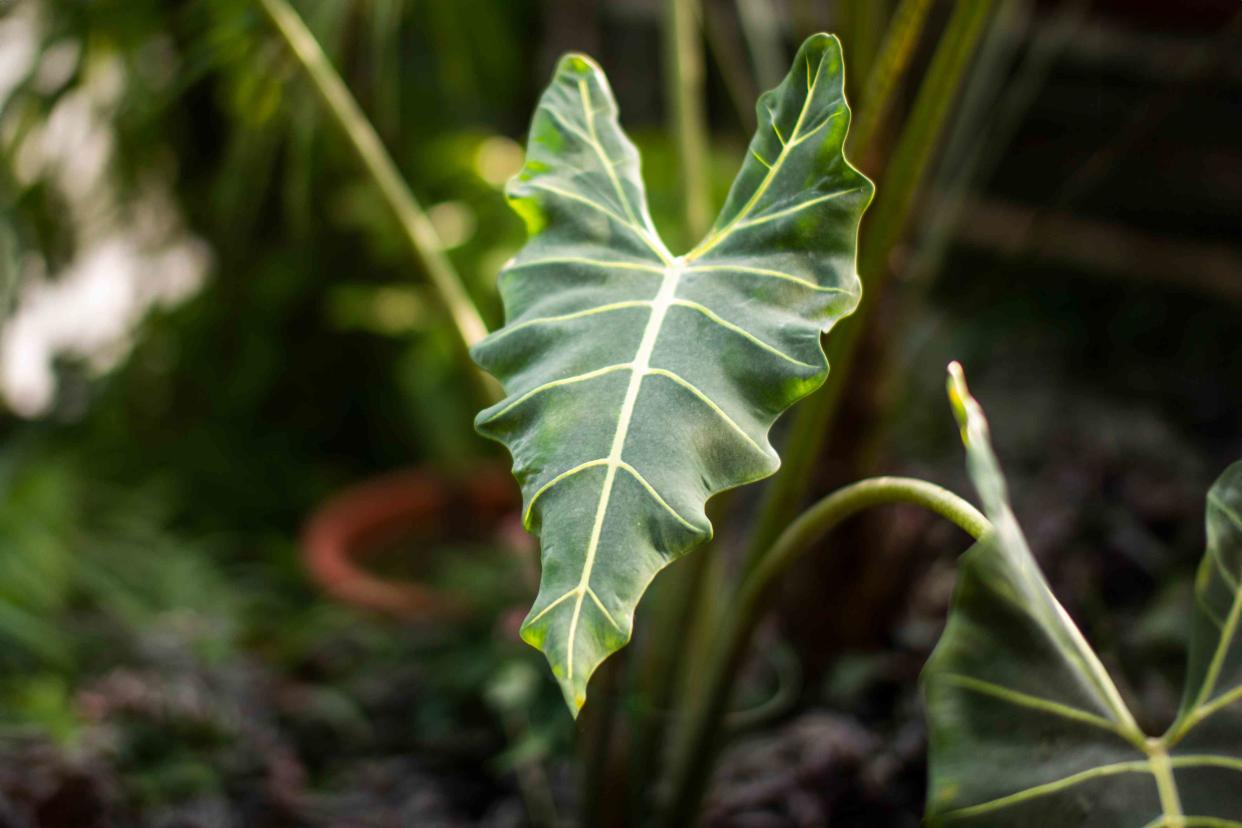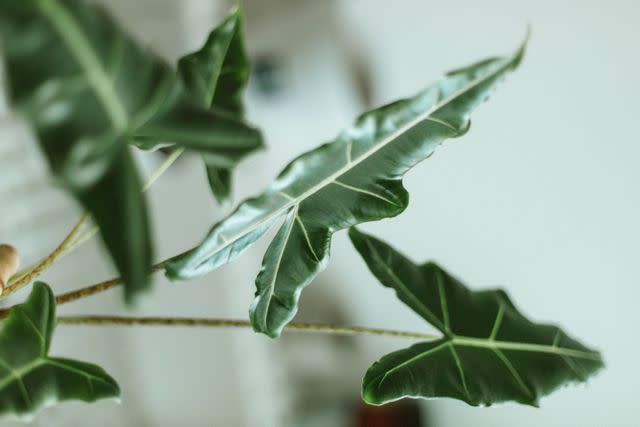Alocasia Sarian Is the Perfect Houseplant for Your Bathroom—Here's How to Grow It

DuKai photographer / Getty Images
Alocasia sarian is a tropical plant native to the Philippines that's grown as a houseplant in temperate regions. Commonly thought to be a naturally occurring hybrid of Alocasia zebrina and Alocasia micholitziana, it's currently considered a variety of Alocasia macrorrhizos, or giant taro. The plant is prized for its pointy-edged, white-veined, arrow-shaped leaves and pale green stems striped with deep red.
Alocasia sarian grows best in warm, humid conditions. The plant requires bright, indirect light, temperatures between 62°F and 72°F, and acidic, well-drained soil. Like other types of alocasia plants, alocasia sarian is toxic to people and pets.
Common Name | Elephant ear |
Botanical Name | Alocasia 'Sarian' |
Family | Araceae |
Plant Type | Perennial, bulb |
Mature Size | Up to 5 ft. tall indoors, up to 12 ft. tall outdoors |
Sun Exposure | Partial |
Soil Type | Most but well-drained |
Soil pH | Acidic, neutral |
Hardiness Zones | 10-11 (USDA) |
Native Area | Philippines |
Toxicity | Toxic to humans, dogs, cats, and horses |

DuKai photographer / Getty Images
Alocasia Sarian Care
Give plenty of bright, indirect light.
Plant in an acidic, well-drained potting mix that holds moisture.
Water to keep the soil consistently moist.
Fertilize with balanced houseplant fertilizer.
Light
Alocasia sarian grows best with bright, indirect light or dappled light if kept outdoors. Keep houseplants in an east-facing window, where they'll receive weaker morning light, or several feet from a south-facing or west-facing window, where they'll be protected from stronger afternoon sun. Ensure that plants are out of direct sunlight, which can burn their leaves.
Soil
Plant alocasia sarian in a loose, rich potting mix with good drainage and peat moss or coco coir to hold moisture. Standard houseplant potting mix can work well, or you can add a few handfuls of perlite or orchid bark to enhance drainage.
Water
Keep alocasia sarian's soil evenly moist but not soggy. These tropical plants enjoy consistent moist soil, but overly wet soils can cause fungal issues like root rot. Water when the surface of the soil has just begun to dry out. Empty saucers and cache pots to make sure the plant isn't sitting in water.
Temperature and Humidity
This moisture-loving jungle plant grows best with humidity levels at or above 50 percent, which is more humid than the average interior space. To boost humidity, group alocasia sarian together with several other plants to create a more humid microclimate, or run a humidifier near the plant to add moisture to the air.
Alocasia sarian prefers mild temperatures between 60°F and 80°F. Exposure to 50°F or below for more than a few minutes can seriously damage or kill the plant.
Fertilizer
Feed alocasia sarian with a balanced liquid houseplant fertilizer diluted to half strength every two weeks during the growing season. Begin fertilizing when you first see new growth on the plant in late winter or early spring, then continue until fall. Skip fertilizing in fall and winter.
Pruning
There's no need to prune alocasia sarian regularly, but it's a good idea to snip off damaged, yellowed, or dead leaves at the base of the plant as they appear. Take care to remove no more than 25 percent of the plant's total foliage when pruning.
Propagating Alocasia Sarian
You can propagate alocasia sarian by removing basal offsets, or baby plants, from a mature specimen. Wait until you see offsets growing around the base of the mother plant to propagate. It's a good idea to propagate in spring or summer when the plant is in active growth. Before you begin, gather fresh potting mix, small plant pots for the offsets, a sharp, sterilized knife, and water.
Examine the base of your alocasia sarian and look for baby plants growing from the rhizome. If no offsets have emerged, wait until they do to propagate the plant.
If your plant has grown offsets, gently remove the plant from its pot and use your fingers to loosen the soil around the root ball. Identify offsets with well-developed leaves and healthy roots to remove from the mother plant.
Use the knife to slice the offset away from the base of the plant, making sure to keep leaves, stem, and roots connected.
Fill the pots with potting mix. Plant the offsets and the mother plant in individual pots, making sure the soil line hits the same spot on the repotted plants as it did on the original plant. Water the plants well.
Put the divisions in a warm place with bright, indirect light. Keep the soil evenly moist. New leaf growth indicates that the offsets have established.
Potting and Repotting Alocasia Sarian
Plant to repot alocasia sarian every two years or so. Signs that it's time to repot are roots growing out of the holes in the bottom of the pot, roots filling the surface of the pot, or a generally dull appearance and lack of growth.
Use fresh soil and a pot one size larger than the previous pot. Use glazed ceramic or plastic pots with drainage holes for alocasia sarian. Avoid terracotta pots, which wick away moisture and will dry out the soil too quickly.
Common Pests & Plant Diseases
Common houseplant pests like spider mites and mealybugs can affect your plant. Inspect the foliage regularly for sticky honeydew or cottony white egg masses that signal mealybugs.
Yellow spits, dusty-looking leaves, and thin webbing on plants indicate spider mites. Treat infestations with insecticidal soap or horticultural oil.
Common Problems With Alocasia Sarian
Leaves Turning Yellow
Yellowing leaves on lower portions of the plant are a common sign of overwatering. Check the soil moisture and adjust as necessary. In extreme cases, it may be best to repot the plant in fresh soil.
Browning Tips
Overly dry conditions can cause alocasia sarian to develop brown leaf tips with yellow edges. Increase the humidity in the air around your plant.
Frequently Asked Questions
How big does alocasia sarian get?
Alocasia sarian plants can grow up to 5 feet tall as a houseplant or 12 feet tall when grown outdoors year-round in a warm climate.
Is alocasia sarian a hybrid?
Yes. Alocasia sarian is a hybrid of two different species, alocasia zebrina and alocasia micholitziana.
Can alocasia sarian grow indoors?
Yes, alocasia sarian makes an excellent houseplant with the right care and conditions.
Read the original article on The Spruce.

